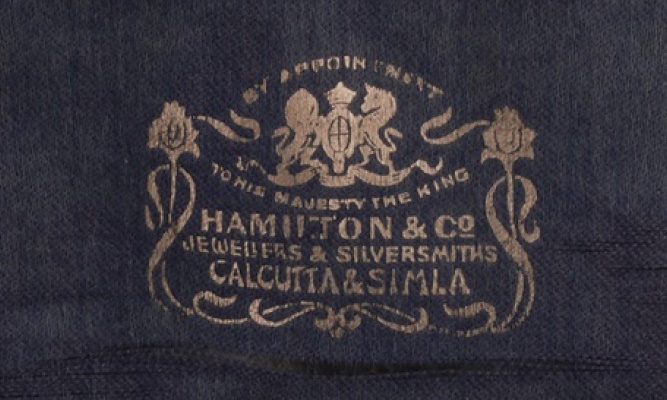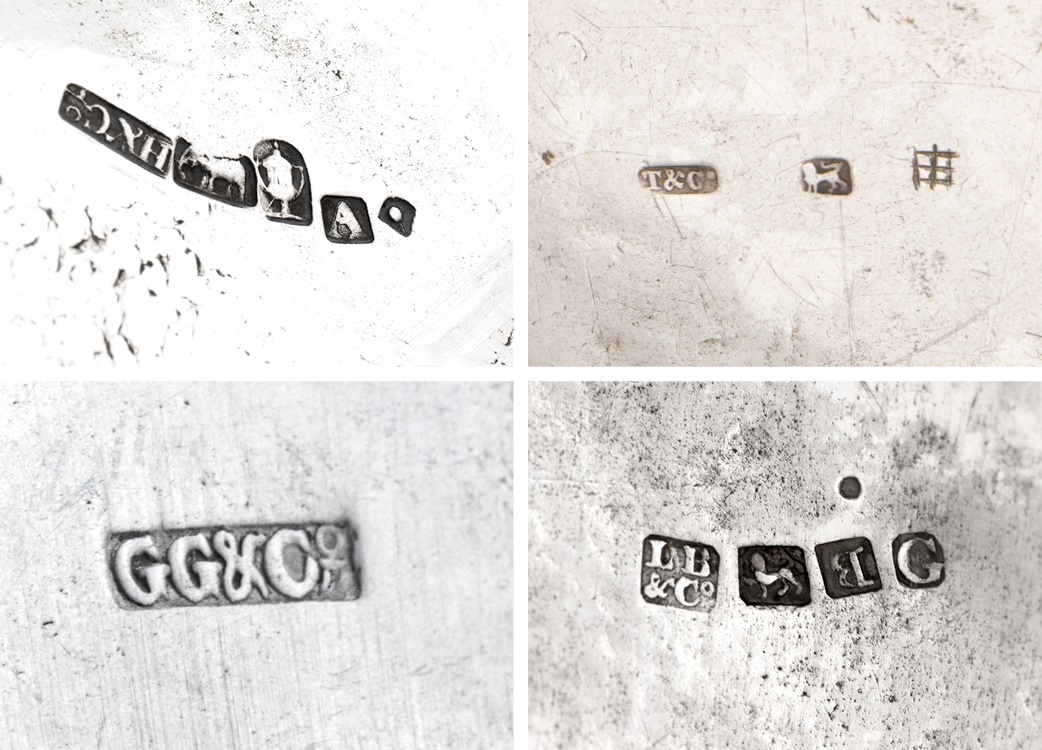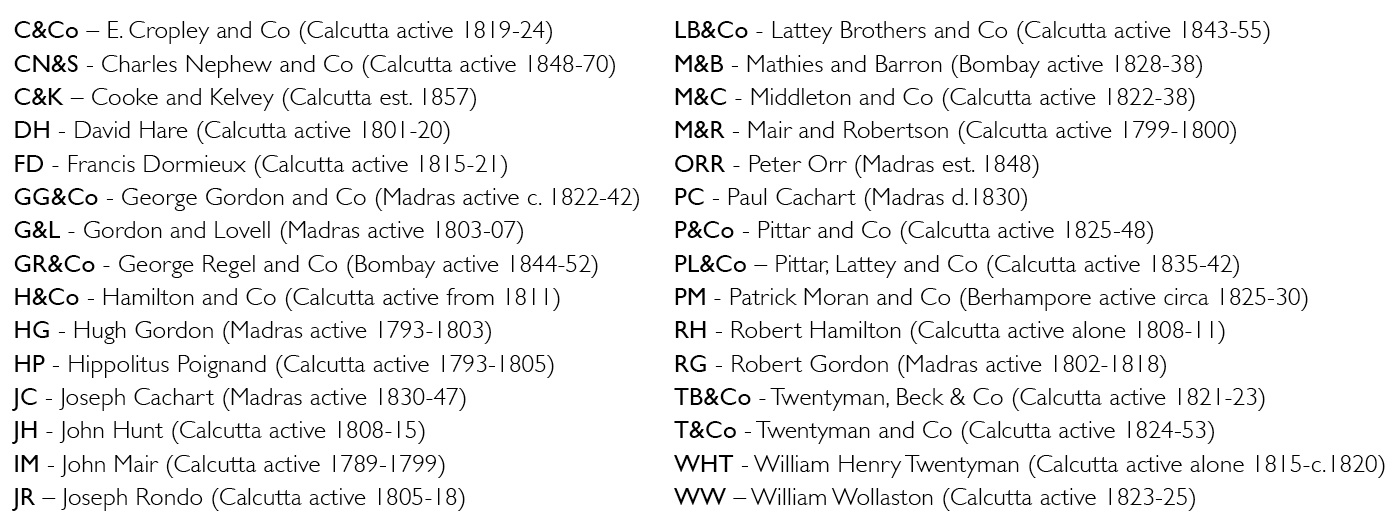

From the late 18th century, as Europeans settled in India in greater numbers, the need for silverware to furnish their homes and support their lifestyles became increasingly apparent. While firms in London initially supplied silver for export to Calcutta, Bombay, and Madras, demand led to the growth of colonial silversmithing in India itself. These workshops produced silver that reflected both European tastes and practical adaptations to the Indian climate.
Colonial firms often marked their pieces with pseudo-hallmarks that imitated the British hallmarking system. These were designed to reassure European buyers that their silver matched the quality of home-produced wares. For around 100 years, from approximately 1780 to 1880, Indian colonial silver enjoyed a rich period of production, representing a unique blend of function, design, and cultural exchange.
By the early 20th century, much of this silver had been forgotten outside specialist circles, except for the work of Hamilton & Co in Calcutta. The revival of interest came in the late 20th century with the identification of many previously misattributed makers’ marks. This has since become a distinct collecting field in its own right.
with a colonial inscription for 1832
Estimate £2,000-£3000
Calcutta
The most prolific centre for colonial silver production. Calcutta-based firms such as Hamilton & Co and Lattey Brothers produced substantial pieces, from tea services and wine ewers to trophies for regattas and gymkhanas. These wares reflected the changing lifestyle of colonial settlers, with items such as curry pans and rice bowls created for the Indian palate.
Madras
Production here was largely driven by the Gordon family across several generations. Peter Orr & Sons, established in 1848, became the leading retail firm in the region. A form distinct to Madras was the ring-handled tureen on a pedestal base.
Bombay, Berhampore and Aurangabad
While smaller, these centres also produced notable pieces. In Bombay, Mathies & Barron were a key firm. Berhampore is known for silver by Patrick Moran, and Aurangabad for rare pieces marked ‘BODRAJ’.

Hamilton & Co, founded in Calcutta in 1808 by Robert Hamilton, became the most recognisable firm of its kind. From small personal items to grand trophies and huqqa bases, their silver was both widely admired and extensively produced. They opened branches in Simla and Bombay and operated until the 1970s.
An early 19th century Indian colonial silver hot water jug, Calcutta circa 1810 by Robert Hamilton
An early 19th century Indian colonial silver covered cup, Calcutta dated 1837 by Hamilton and Co
A mid-19th century Indian colonial silver twin handled cup and cover, Calcutta circa 1860 by Hamilton and Co

Without an assay office system in India, silversmiths used pseudo marks, icons such as lions, anchors, keys, and thistles. Many marks are now attributed to specific makers, with more being uncovered through ongoing scholarship.

Quintessential colonial forms include:
Butter Coolers: designed with liners to keep butter from melting in the heat.
Milk Pans: used to boil milk for safety, often mistaken for brandy pans.
Toffee Pots: dual-purpose tea and coffee pots developed by Hamilton & Co.
Curry Pans: often adaptable with interchangeable parts, including egg coddlers.
Condiment Cruets and Christening Mugs: frequently engraved and made in sets.
An early 19th century Indian colonial unmarked silver butter cooler, Madras circa 1820
A rare set of four mid-19th century Indian colonial silver cruets, Bombay circa 1850 by George Regel and Co (active 1844-52)
A mid-19th century Indian colonial silver milk pan, Calcutta circa 1850 by Hamilton and Co
A mid-19th century Indian colonial silver “toffee” pot, Calcutta circa 1840 by Twentyman and Co (active 1818-20, then 1824-53)
An early 19th century Indian colonial silver small mug, Madras, circa 1814 by Robert Gordon II (active 1802-1818)
An early 19th century Indian colonial silver curry pan with egg coddler, Calcutta circa 1830 by Twentyman and Co (active 1818-20, then 1824-53)
Estimate £1,000-£1,500
By the late 19th century, regional Indian styles began to take precedence, such as the heavily decorated Kashmir work and Madras’s Swami style. Firms like Peter Orr adapted to these trends, reflecting British tastes shaped by international exhibitions. Raj silver gained popularity both in India and abroad, and colonial firms continued to supply ceremonial and practical silver well into the 20th century.
Royal Calcutta Turf Club - An early 20th century Indian Colonial unmarked silver presentation twin-handled trophy, Bangalore circa 1928 by T. Lutchmiah Chetty & Sons
A late 19th century Anglo – Indian silver twin handled bowl, Kashmir circa 1880 retailed by Cooke and Kelvey of Calcutta
Literature:
Wilkinson W., The Makers of Indian Colonial Silver, (1987), London: Wynyard R T Wilkinson.
Wilkinson W., Indian Colonial Silver – European Silversmiths in India and their marks (1790-1860), (1973), London: Wynyard R T Wilkinson.
Wilkinson, W., (1999)., Indian Silver 1858-1947: Decorative Silver from the Indian Sub-Continent and Burma Made by Local Craftsmen in Western Forms. London: Wynyard R T Wilkinson.
Get in touch with our Head of Silver & Objects of Vertu Department, John Rogers, at john.rogers@chiswickauctions.co.uk or submit an online valuation.